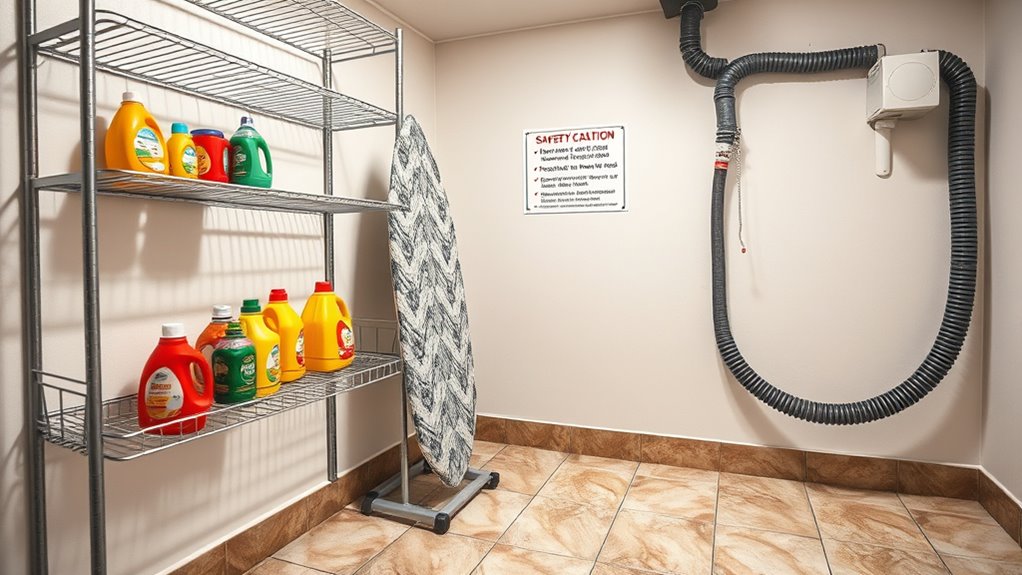To keep your laundry room safe, guarantee appliances are securely stacked at manageable heights to prevent falls and strain. Regularly inspect hoses for cracks or leaks, replacing worn ones with durable metal-braided options and securing connections tightly. Manage heat by cleaning vents often and avoiding overloading dryers, which can cause overheating or fires. Paying attention to these safety tips helps protect your home and loved ones—discover more ways to enhance your laundry room safety as you go along.
Key Takeaways
- Ensure appliances are securely installed and anchored to prevent toppling, especially when stacked or placed on elevated surfaces.
- Regularly inspect and replace aging hoses with durable, metal-braided options, securing connections to prevent leaks and disconnections.
- Keep dryer vents clean and unobstructed to prevent lint buildup, reducing fire risk caused by excessive heat and flammable debris.
- Avoid overloading dryers to maintain proper airflow, and keep heat sources away from combustible materials for fire safety.
- Manage appliance heights for safe access, minimizing strain or falls when loading or unloading laundry.

Have you ever considered how safe your laundry room really is? It’s easy to focus on clean clothes and forget about potential hazards lurking behind the scenes. Yet, safety should be a top priority, especially when it comes to heights, hoses, and heat. These elements can pose serious risks if not properly managed. For instance, laundry appliances are often placed on elevated surfaces or stacked to save space. While this might seem convenient, it can also be dangerous if the machines aren’t securely installed. An unstable stack could topple over, causing injury or damage. If you’re stacking your washer and dryer, double-check that they’re anchored properly and that the height is manageable for safe loading and unloading. Don’t forget that reaching into a high dryer can strain your back or lead to accidental falls if you’re not careful. Additionally, proper installation techniques are essential to ensure stability and safety. Hoses are another critical safety concern. The hoses connecting your washing machine to the water supply can deteriorate over time, leading to leaks or even flooding. Regularly inspect these hoses for signs of wear—cracks, bulges, or leaks—and replace them if needed. Using durable, metal-braided hoses is a smart choice, as they’re less prone to bursting than rubber ones. Properly securing the hoses prevents accidental disconnections during operation, which can cause water damage and create slippery floors. Also, avoid over-tightening fittings, as this can weaken the hoses and increase the risk of rupture. Remember, a small leak might seem insignificant, but it can escalate quickly and cause extensive damage, especially if left unnoticed. Heat is another element that demands your attention. Laundry rooms often generate a lot of warmth, especially around dryers. Excessive heat can be a fire hazard if not properly ventilated or maintained. Ensure your dryer vent is clear of lint buildup, as lint is highly flammable. Regularly clean the lint filter and schedule professional vent cleaning at least once a year. Avoid overloading your dryer, which can cause it to overheat or work inefficiently. Also, keep combustible materials away from heat sources, and never operate a dryer with a malfunctioning thermostat or vent. High temperatures can also cause damage to hoses or electrical components, increasing the risk of fire. It’s essential to monitor the temperature and make sure your appliances are functioning correctly to prevent heat-related accidents.
Frequently Asked Questions
How Often Should I Inspect My Laundry Room for Hazards?
You should inspect your laundry room for hazards at least once a month. Regular checks help you identify potential issues like loose shelves, frayed hoses, or blocked vents before they become serious problems. Keep an eye out for leaks, damaged cords, or heat sources that could cause fires. Staying proactive guarantees your laundry space remains safe and functional, reducing risks and preventing accidents.
Are There Specific Safety Guidelines for Children in Laundry Rooms?
Did you know that children under five are twice as likely to be injured in laundry rooms? To keep kids safe, always supervise them around appliances, store detergents and chemicals out of reach, and secure hoses and cords so they can’t be pulled or tripped over. Never leave children unattended in the laundry area, and educate them about potential hazards to prevent accidents. Your vigilance can make a big difference.
What Are the Best Materials for Laundry Room Flooring to Prevent Slips?
You should choose slip-resistant materials like textured vinyl, rubber, or textured tiles for your laundry room flooring. These options provide better grip, reducing the risk of slips and falls, especially when floors are wet. Avoid smooth surfaces like polished stone or ceramic without a slip-resistant coating. Regularly clean and dry the floor, and consider adding mats or rugs in high-traffic areas to enhance safety.
Can Certain Detergents Increase Fire Risk in the Laundry Area?
Certain detergents can indeed increase fire risk in your laundry area. I once heard about a dryer fire caused by a highly flammable detergent buildup. These products often contain volatile chemicals that, when heated or combined with lint, can ignite. To stay safe, choose detergents with safer formulas, avoid overusing them, and regularly clean your dryer vent and lint trap to reduce the chances of a fire starting.
How Do I Properly Dispose of Old or Damaged Hoses?
You should dispose of old or damaged hoses by checking local recycling programs or hazardous waste facilities. First, detach the hose from your washer or dryer, then drain any remaining water and cut it into manageable pieces. Place the hose in your recycling bin if accepted, or take it to a designated disposal site. Never throw hoses in regular trash if they contain chemicals or hazardous materials.
Conclusion
By mastering laundry room safety, you’re practically invincible against fires, floods, and electrical mishaps—your laundry room becomes a fortress of security! Remember, neglecting heights, hoses, and heat isn’t just risky; it’s like inviting disaster to dance right at your doorstep. Stay vigilant, follow safety tips, and turn your laundry space into a sanctuary of serenity. With these precautions, you’ll keep hazards at bay and guarantee your laundry routine remains safe, smooth, and unstoppable!









